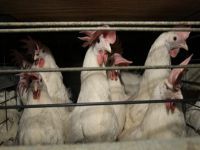
Bird Flu: It's getting worse

The Vietnamese Ministry of Health has confirmed the death of an eighteen-year-old man from Kien Giang Province, who developed symptoms on January 10, was hospitalised on January 12 and died on January 14. 60 patients of the 120 cases registered in Vietnam with A H5N1 have died.
From time to time the international media needs to wake up and remember that there is a deadly virus lurking out there with a mortality rate far superior to the Black Death and between twenty and thirty times higher than Spanish Flu, which killed around 50 million people from 1918-1919. This is such a time.
The Indonesian health Ministry has confirmed another case of death occasioned by Influenza A H5N1 in a human - a five-year-old girl from the Province of Jakarta. She was hospitalised on January 7, developed severe breathing difficulties on January 13 and died on January 16. This is the latest of 184 Bird Flu cases in Indonesia, of which 152 have been fatal - a fatality rate of 82 per cent. She had close family contact with case 183 and was exposed to the same pigeons that caused that case.
In Egypt, the Ministry of Health and Population has confirmed two more human cases of A H5N1 - a two-year-old girl from Cairo Governorate, hospitalised, with a family history of contact with backyard poultry and a 31-year-old male from Fayium Governorate, who is also hospitalised and in a critical care unit. In Egypt, 55 of the 159 cases of A H5N1 have been fatal.
In Cambodia, 17 patients of the 19 cases with A H5N1 have died, the latest fatality occurring on January 18.
WHO: The importance of monitoring Influenza variants
The World Health Organization this week reported "several human infections with variant influenza viruses currently thought to be circulating in swine populations" which have so far been contained to small clusters. The WHO also refers to the incidence of bird-to-human transmission of Bird Flu, or A H5N1, which is also contained inside clusters.
However, claims the WHO, "because influenza viruses are unpredictable, they have the possibility to change and become more transmissible among humans as shown by the emergence of the influenza pandemic H1N1 virus in 2009". The WHO therefore urges all health authorities to be vigilant and reminds them it is compulsory to report all new strains of flu observed.
Scientists create H5N1: Bird Flu - Twice as deadly as the Black Death
If A H1N1 (Swine Flu) had a high incidence rate and a mortality rate at the higher end of the normal parameters, then A H5N1 (Bird Flu) is entirely different, having a global mortality rate of around 60%. That is why scientists, for purposes of studying this strain further, have performed genetic alterations on the H5N1 virus in a laboratory environment (5 alterations) and have managed to create an airborne strain which would provide human-to-human transmission. In plain language, it would be twice as virulent and deadly as the Black Death.
The new strain produced eventually proved to be highly transmissible among laboratory ferrets, generally considered to be a good indication as to what would happen among humans, something that has the biosecurity community hearing alarm bells ringing because of a potential leak or the threat of the secret falling into the wrong hands.
The researchers made five changes to the genetic composition of the virus and observed how it interacted with the respiratory tract, so as to better understand the mechanisms which might be involved in a human-to-human transmissible H5N1 outbreak. The alterations allowed the virus to attack to nasal and tracheal cells, however it was still initially difficult to spread through close contact. Therefore, the research team decided to make it easier.
Exposing ferrets to infected material from other ferrets injected with the virus, and repeating the process ten times, they managed to develop a strain of H5N1 as transmissible as seasonal flu. This latest research has horrified some sections of the medical community, which consider that is is not a good idea to turn a deadly virus into a highly contagious one, much less publish the results. For this reason the details of the research are as yet unavailable.
1918 Spanish Flu
This would not be the first time a deadly Influenza virus has been created, however. In 2005, scientists at the Centers for Disease Control and Prevention (CDC) reconstructed the H1N1 1918 Pandemic Influenza virus (Spanish Flu), which killed between 50 and 100million people worldwide. The entire gene sequence of this virus was deciphered and the scientists were able to recreate viruses with similar characteristics.
The H1N1 Pandemic Influenza virus was the worst outbreak in history and genetically, it was different from any other flu viruses that had hitherto attack humans. The US-based researcher and scientist Jeffery Taubenberger has described the 1918 virus as "the most bird-like of all mammalian flu viruses".
Food for thought. It is evident that with the constant mutations occurring to the Influenza virus, sooner or later a species leap may occur. Until it does, let us all remember a few basic steps we can take to avoid contagion.
* If you are sick, stay at home;
* Cough or sneeze into a tissue or the bend of your arm. Dispose of the tissue down a flush toilet;
* Wash the hands frequently;
* Use a sanitising hand gel regularly;
* Wipe all surfaces you touch upon arriving home with a tissue soaked in an alcohol-based substance or sanitising hand gell, namely door handles, keys, light switches and taps;
* When outside, avoid touching surfaces where the flu virus can collect, such as door handles, elevator buttons, etc. Wear gloves, use sanitizing hand gel upon arrival in a building. Avoid touching the mouth or eyes.
Timothy Bancroft-Hinchey
Pravda.Ru